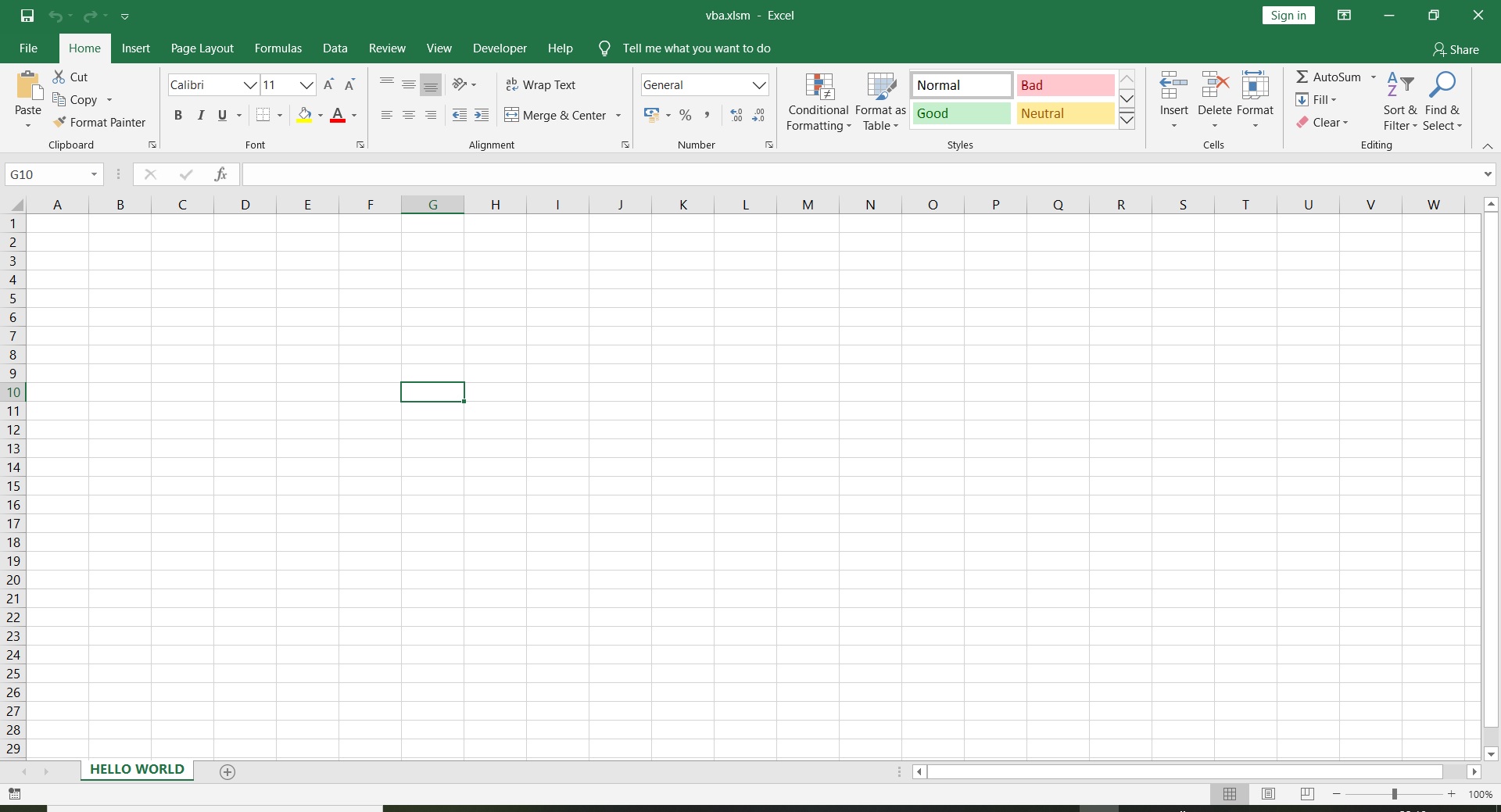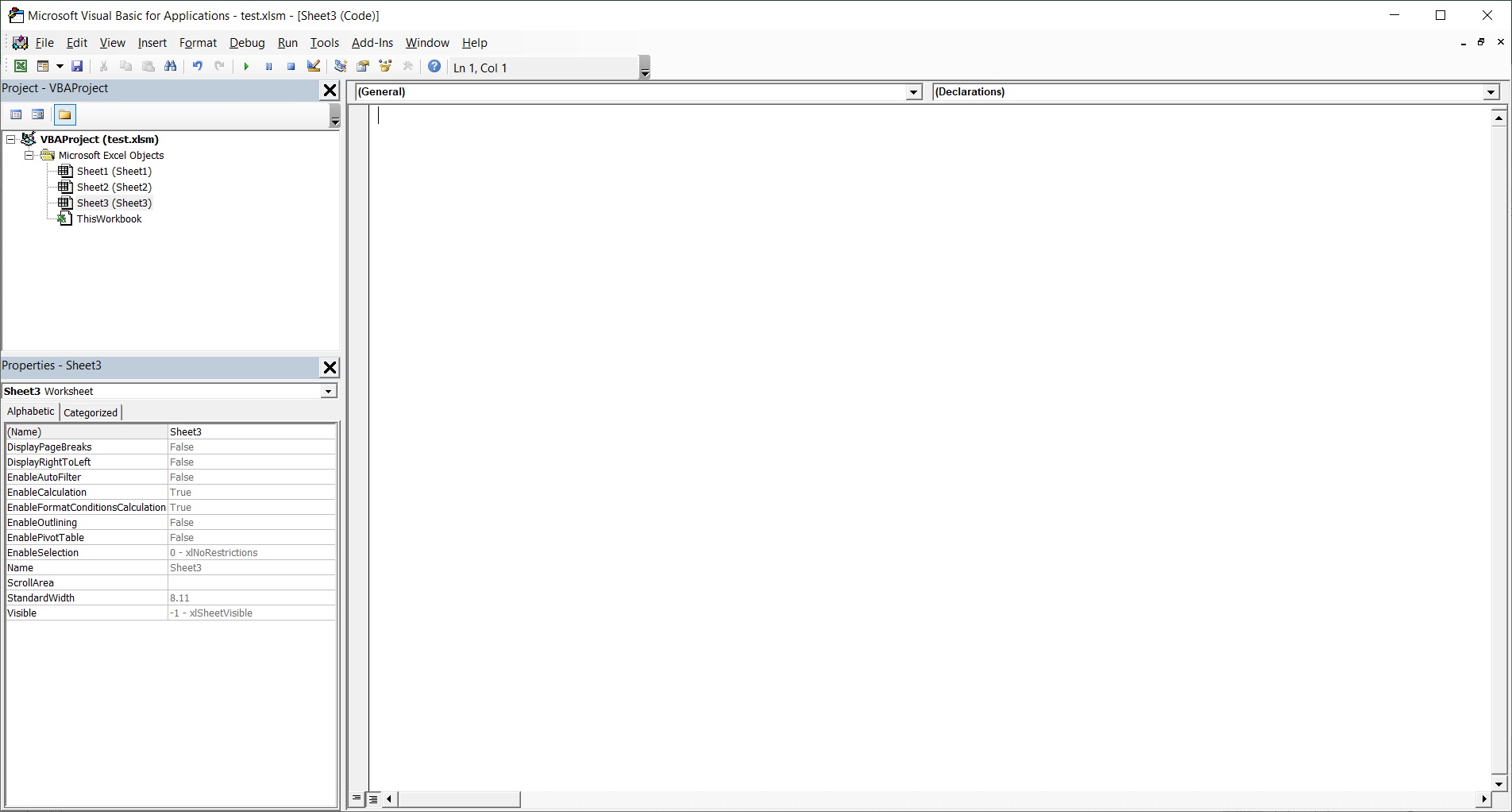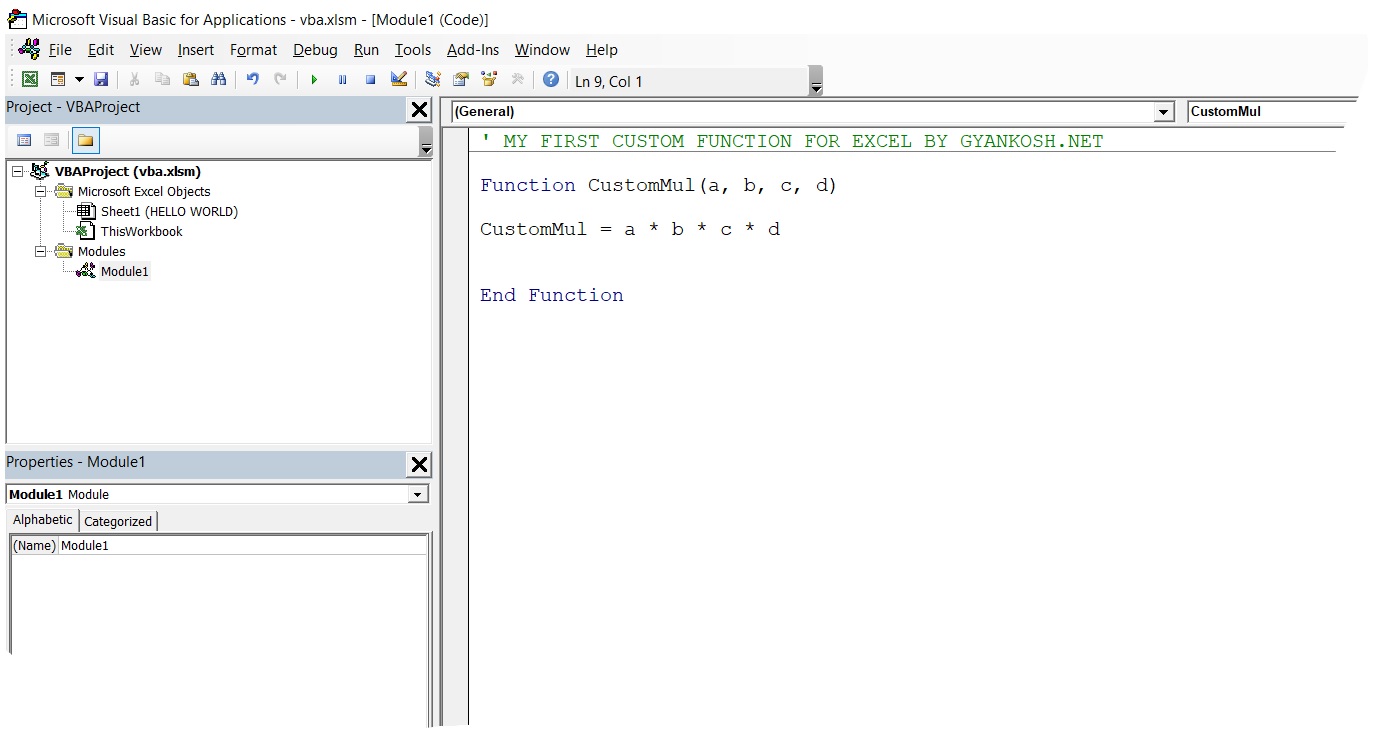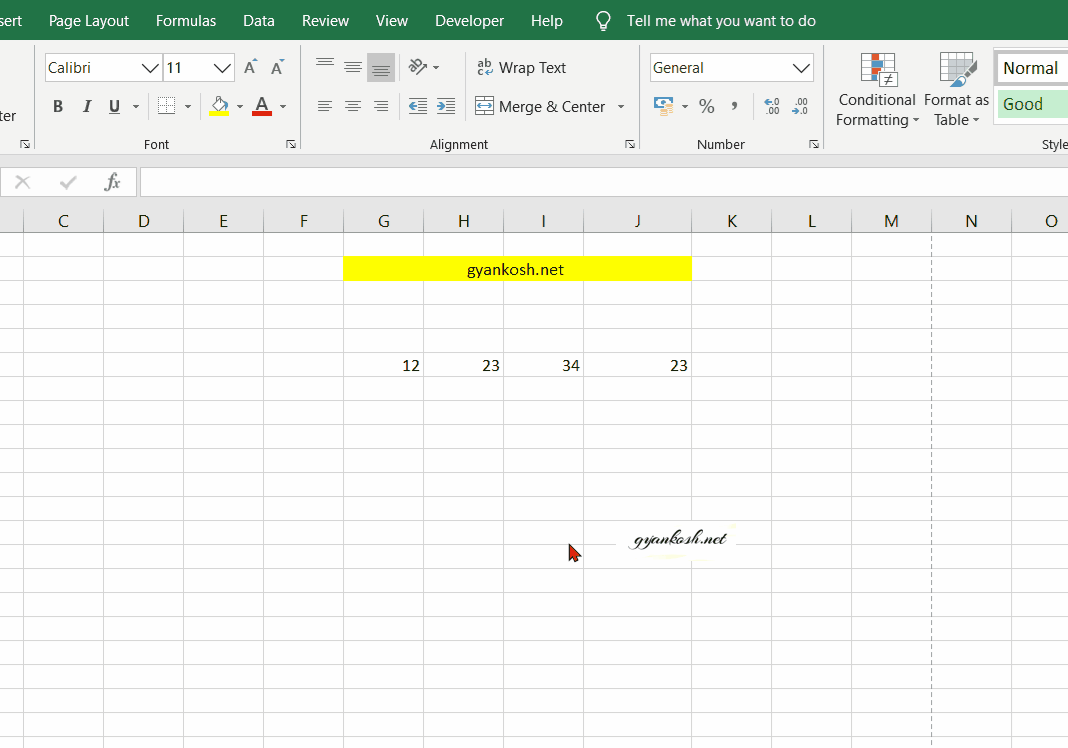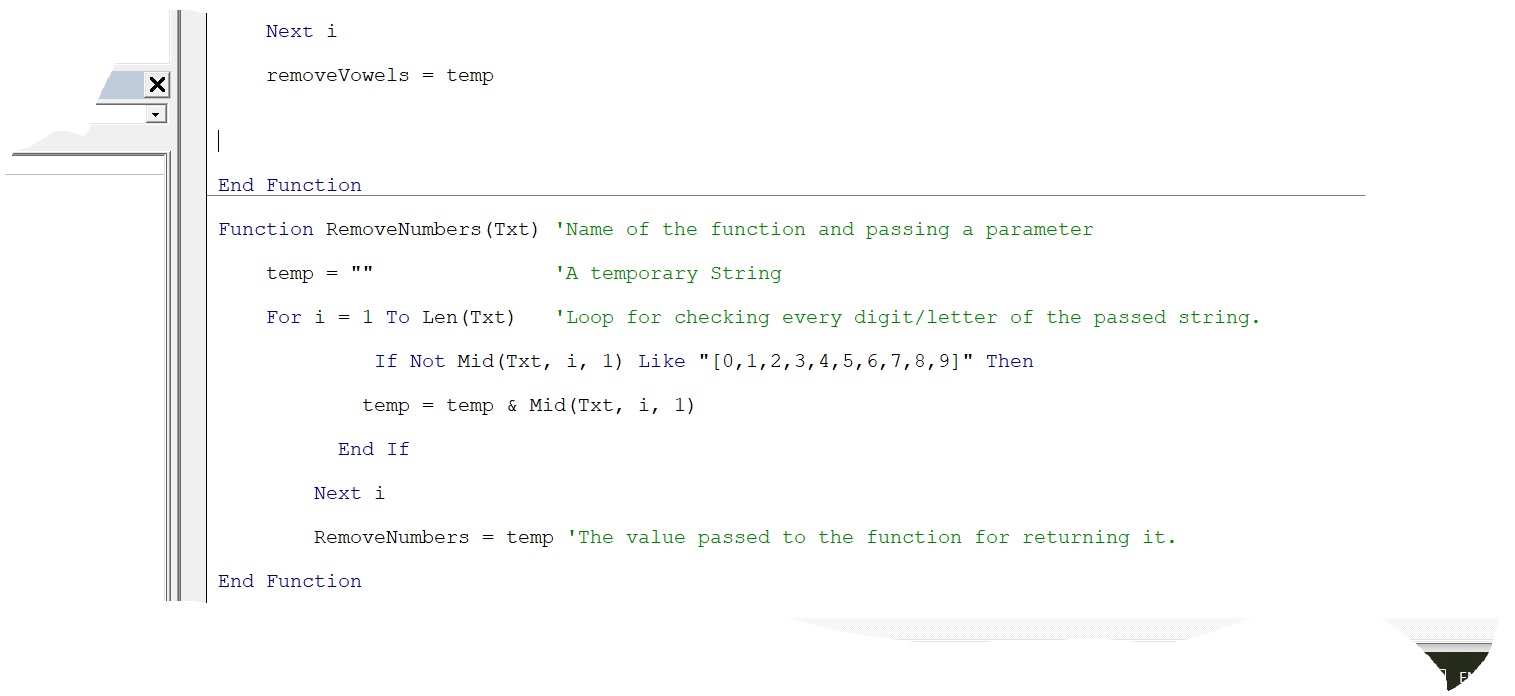Table of Contents
- INTRODUCTION
- FIRST STEP
- WRITING THE PROGRAM
- PRE PLANNING THE FUNCTION STRUCTURE
- WRITING THE CODE FOR CUSTOM FUNCTION
- USING THE CUSTOM CODE FUNCTION
- WRITING THE CODE FOR CUSTOM FUNCTION-2
- USING THE FUNCTION
INTRODUCTION
We have created our first program HELLO WORLD using the sub procedures or a simple set of statements.
The statement in the sub procedures are executed in a line, unless there is some control which switches the control out of the line, which we’ll learn later in the course.
How many times has it happened that we want to do something specific in EXCEL but we are limited with the availability of the BUILT-IN functions and we say that it can’t be done. So, for such a situation, we have got the power of VBA where we can create our own custom function.
The custom function can be as complex as we want and we can make it do many many things which are not possible otherwise.
So , in this article we are going to create a custom excel function with the use of VBA[ Visual Basic for Applications] for Excel.
The article repeats some of the steps for the friends who haven’t gone through the previous post.
FIRST STEP
OPENING THE EXCEL
- Double Click the Excel icon and start the application.
- The Excel will ask you about the kind of worksheet we want to open.
- Choose BLANK WORKBOOK and click ok.
- Now we are inside the excel with a blank workbook opened before us.
CHECKING THE STATUS OF DEVELOPER TAB
- After opening the Excel
- Check if DEVELOPER TAB is visible or not. If not refer to the previous post regarding the same process.
- After the developer tab is visible, go to developer tab.
- Click Visual Basic.
- Now we have reached the visual basic window.
- In VBE, add a module to the project folder as shown in the following post.[Adding a module]
- We’ll write down the function program in the module.
In the welcome window of Excel, you can see that I have already saved the file with a name.
That is all your preference as I just love to repeatedly do CTRL+S to keep the data saved to avoid any problem. you can also save now or later by pressing CTRL+S or going to FILE MENU and then save. The save dialog box will open for the first time asking you for the location and name of the file and its type of course.
WRITING THE PROGRAM
OUT OF THE FOUR TYPES DISCUSSED, WE’LL USE THE SUB PROCEDURE FIRST. .
Just to remind of the format of the function, Function in the VBA is written in the following format function
name_of_function(arguments to be passed)
.
.
.
.
.
End Function
PRE PLANNING THE FUNCTION STRUCTURE
Before we create any function, it is very important to make a plan of the function. There are a few things that should be taken care of:
- If any argument is passed or not.
- Number of arguments to be passed into the function
- If the returning value will be single or an array
- The way, calculation will be done
etc.
So here, for the sake of understanding, we will create a small function where we will multiply the four numbers passed into the function.
Name of the function will be CustomMul (custom multiplication)
Four arguments will be passed into the function i.e. four numbers
Returning value will be one, the multiplication of all the numbers.
So let us see the code of the function first.
WRITING THE CODE FOR CUSTOM FUNCTION
CODE
‘ MY FIRST CUSTOM FUNCTION FOR EXCEL BY GYANKOSH.NET
Function CustomMul(a, b, c, d)
CustomMul = a * b * c * d
End Function
After typing the code, save the file by clicking the save button in the toolbar.
PICTURE [HOW TO ENTER CODE]
The code entered by you will look somewhat like the one shown in the picture below.
EXPLANATION
The function is shown above.
The function takes four inputs as a,b,c,d
After the values are passed into the function, the calculation is done as
CustomMul=a*b*c*d
and put the value in the function, which will be returned when we use the function. * We will also take care of data types later.
MsgBox(“Any Text”)
This method displays the text entered in a small window which you must have seen in many applications.
USING THE CUSTOM CODE FUNCTION
After saving the function, now the function will be listed in our function library.
We can use this function in the workbook anywhere. Let us try to use the function.
EXPLANATION
There are four numbers present in four different columns and we need the multiplication result for all the four numbers.
So we put the function in the cell as
=customMul(G6,H6,I6,J6)
where the cells G6, H6, I6, and J6 contain the four numbers to be multiplied.
The answer appear as 215832 which is correct.
The numbers can be passed directly also.
CONGRATULATIONS!!! THE FIRST FUNCTION HAS BEEN CREATED BY YOU!!
WRITING THE CODE FOR CUSTOM FUNCTION-2
OBJECTIVE OF THE FUNCTION
TO CREATE A FUNCTION THAT REMOVES NUMBERS FROM THE TEXT
PRE PLANNING OF THE FUNCTION
Let us plan the way we would try to solve this problem.
1. The input is going to be a TEXT which we need to operate upon, which means that we need to pass an argument as TEXT.
2. Let us name the function as RemoveNumbers.
3. After the passing of Text, we need to find out which component is a digit and which one is a letter. For this, we’ll compare the digits/letters one by one with an array that contains the digits 0 to 9.
4. We’ll make a temporary string, where we will add the letters and discard the numbers.
5. We’ll get our result.
CODE
Function RemoveNumbers(Txt) 'Name of the function and passing a parameter temp = "" 'A temporary String For i = 1 To Len(Txt) 'Loop for checking every digit/letter of the passed string. If Not Mid(Txt, i, 1) Like "[0,1,2,3,4,5,6,7,8,9]" Then temp = temp & Mid(Txt, i, 1) End If Next i RemoveNumbers = temp ' The value passed to the function for returning it. End Function
PICTURE [HOW TO ENTER CODE]
LEN(STRING) This function returns the length of the given string as a number. Suppose we put LEN(“HELLO”), it’ll return 5 as the answer.
EXPLANATION
The code of the function is shown above. We can copy the code and paste it into the VBE window. Let us try to understand the code. Although a few comments are given already.
We started by declaring the name and passing one argument into the function which will be a string(Text).
After this, we started a temporary string named TEMP.
A FOR loop is used which will start from i=1 up to the length of the text. [FUNCTION LEN(TEXT) gives the length of the string/text)
Next, we check if the particular digit/letter is NOT matching any number from the array i.e. if it’s a text then, we add that letter to the string TEMP using a concatenate operator (&).
End the IF statement.
After the loop is complete the string temp will be having all the letters and no numbers.
Pass the value to the function name so that it can return it.
End the function.
‘ ( Text followed by an apostrophe) Comments can be put anywhere inside the code starting with an apostrophe. Commenting is very necessary for code understanding.
USING THE FUNCTION
After saving the function, now the function will be listed in our function library.
We can use this function in the workbook anywhere. Let us try to use the function.
EXPLANATION
A sample text is there in cell G8 which is a random blend of letters and numbers.
‘The text is =asdf465sdf456sdf564f
We put the function as
=RemoveNumbers(G8)
and the answer appears without the numbers asdfsdfsdff which is correct.
Now we can use this function anywhere in the workbook without even bothering about the code just like the EXCEL BUILT IN functions.
